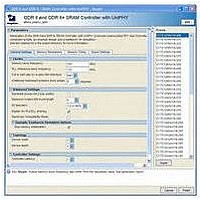IPR-QDRII/UNI Altera, IPR-QDRII/UNI Datasheet - Page 58

IPR-QDRII/UNI
Manufacturer Part Number
IPR-QDRII/UNI
Description
IP CORE Renewal Of IP-QDRII/UNI
Manufacturer
Altera
Datasheet
1.IP-QDRIIUNI.pdf
(74 pages)
Specifications of IPR-QDRII/UNI
Software Application
IP CORE, Memory Controllers, SRAM
Supported Families
Arria II GX, HardCopy III, Stratix III, Stratix IV
Core Architecture
FPGA
Core Sub-architecture
Arria, HardCopy, Stratix
Rohs Compliant
NA
Lead Free Status / RoHS Status
na
- Current page: 58 of 74
- Download datasheet (3Mb)
6–18
External Memory Interface Handbook Volume 3
Section III. QDR II and QDR II+ SRAM Controller with UniPHY User Guide
Figure 6–12
read from the same address. In each example, afi_rdata and afi_wdata are aligned
with controller clock (afi_clk) cycles. All the data in the bit vector is valid at once.
The AFI has the following conventions:
■
■
Figure 6–12
■
■
■
With the AFI, high and low signals are combined in one signal, so for a single
chip-select (afi_cs_n) interface, afi_cs_n[1:0], where location 0 appears on the
memory bus on one mem_clk cycle and location 1 on the next mem_clk cycle.
1
Spaced reads and writes have the following definitions:
■
■
The burst length is four.
An 8-bit interface with one chip-select.
The data for one controller clock (afi_clk) cycle represents data for two memory
clock (mem_clk) cycles (half-rate interface).
Spaced writes—write commands separated by a gap of one controller clock
(afi_clk) cycle.
Spaced reads—read commands separated by a gap of one controller clock
(afi_clk) cycle.
This convention is maintained for all signals, so for an 8 bit memory
interface, the write data (afi_wdata) signal is afi_wdata[31:0], where the
first data on the DQ pins is afi_wdata[7:0], then afi_wdata[15:8], then
afi_wdata[23:16], then afi_wdata[31:24].
and
through
Figure 6–13
Figure 6–13
show writes and reads, where the data is written to and
assume the following general points:
Chapter 6: Functional Description—UniPHY
December 2010 Altera Corporation
PHY-to-Controller Interfaces
Related parts for IPR-QDRII/UNI
Image
Part Number
Description
Manufacturer
Datasheet
Request
R

Part Number:
Description:
CYCLONE II STARTER KIT EP2C20N
Manufacturer:
Altera
Datasheet:

Part Number:
Description:
CPLD, EP610 Family, ECMOS Process, 300 Gates, 16 Macro Cells, 16 Reg., 16 User I/Os, 5V Supply, 35 Speed Grade, 24DIP
Manufacturer:
Altera Corporation
Datasheet:

Part Number:
Description:
CPLD, EP610 Family, ECMOS Process, 300 Gates, 16 Macro Cells, 16 Reg., 16 User I/Os, 5V Supply, 15 Speed Grade, 24DIP
Manufacturer:
Altera Corporation
Datasheet:

Part Number:
Description:
Manufacturer:
Altera Corporation
Datasheet:

Part Number:
Description:
CPLD, EP610 Family, ECMOS Process, 300 Gates, 16 Macro Cells, 16 Reg., 16 User I/Os, 5V Supply, 30 Speed Grade, 24DIP
Manufacturer:
Altera Corporation
Datasheet:

Part Number:
Description:
High-performance, low-power erasable programmable logic devices with 8 macrocells, 10ns
Manufacturer:
Altera Corporation
Datasheet:

Part Number:
Description:
High-performance, low-power erasable programmable logic devices with 8 macrocells, 7ns
Manufacturer:
Altera Corporation
Datasheet:

Part Number:
Description:
Classic EPLD
Manufacturer:
Altera Corporation
Datasheet:

Part Number:
Description:
High-performance, low-power erasable programmable logic devices with 8 macrocells, 10ns
Manufacturer:
Altera Corporation
Datasheet:

Part Number:
Description:
Manufacturer:
Altera Corporation
Datasheet:

Part Number:
Description:
Manufacturer:
Altera Corporation
Datasheet:

Part Number:
Description:
Manufacturer:
Altera Corporation
Datasheet:

Part Number:
Description:
CPLD, EP610 Family, ECMOS Process, 300 Gates, 16 Macro Cells, 16 Reg., 16 User I/Os, 5V Supply, 25 Speed Grade, 24DIP
Manufacturer:
Altera Corporation
Datasheet:











